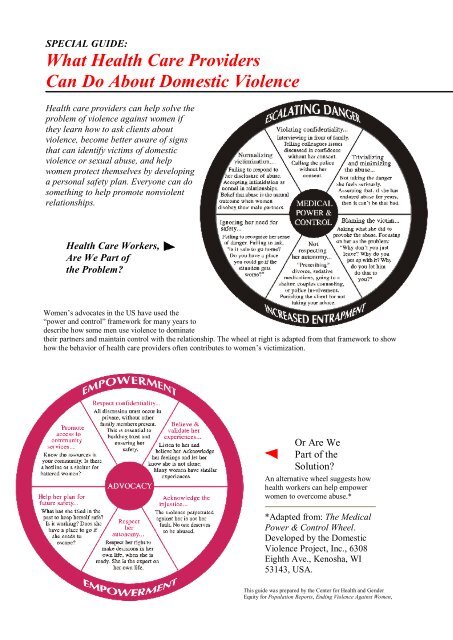Pullout Guide - General Practice Conference & Medical Exhibition
Pullout Guide - General Practice Conference & Medical Exhibition
Pullout Guide - General Practice Conference & Medical Exhibition
Create successful ePaper yourself
Turn your PDF publications into a flip-book with our unique Google optimized e-Paper software.
SPECIAL GUIDE:<br />
What Health Care Providers<br />
Can Do About Domestic Violence<br />
Health care providers can help solve the<br />
problem of violence against women if<br />
they learn how to ask clients about<br />
violence, become better aware of signs<br />
that can identify victims of domestic<br />
violence or sexual abuse, and help<br />
women protect themselves by developing<br />
a personal safety plan. Everyone can do<br />
something to help promote nonviolent<br />
relationships.<br />
Health Care Workers,<br />
Are We Part of<br />
the Problem<br />
Women’s advocates in the US have used the<br />
“power and control” framework for many years to<br />
describe how some men use violence to dominate<br />
their partners and maintain control with the relationship. The wheel at right is adapted from that framework to show<br />
how the behavior of health care providers often contributes to women’s victimization.<br />
Or Are We<br />
Part of the<br />
Solution<br />
An alternative wheel suggests how<br />
health workers can help empower<br />
women to overcome abuse.*<br />
*Adapted from: The <strong>Medical</strong><br />
Power & Control Wheel.<br />
Developed by the Domestic<br />
Violence Project, Inc., 6308<br />
Eighth Ave., Kenosha, WI<br />
53143, USA.<br />
This guide was prepared by the Center for Health and Gender<br />
Equity for Population Reports, Ending Violence Against Women,
Series L, No. 11, December 1999.<br />
How to Ask About Abuse<br />
One day after reading an educational booklet on domestic violence, Richard Jones, former president<br />
of the American College of Gynecologists and Obstetricians, asked a long-time patient whether her<br />
husband had ever beaten her. To his amazement, she replied, “Doctor Jones, you can’t imagine how long<br />
I’ve been waiting for you to ask me that question” (242).<br />
Any service provider can make a difference by “asking the question.” Jones now asks every patient about<br />
abuse and encourages all of his students to do likewise. An important first step is considering how to<br />
broach the subject and then developing a standard way to ask the question for all clients. Here are some<br />
options:<br />
Introducing the Question<br />
"Before we discuss contraceptive choices, it might be good to<br />
know a bit more about your relationship with your partner.”<br />
“Because violence is common in women’s lives, we have begun<br />
asking all clients about abuse.”<br />
“I don’t know if this is a problem for you, but many of the<br />
women I see as clients are dealing with tensions at home. Some<br />
are too afraid or uncomfortable to bring it up themselves, so I’ve<br />
started asking about it routinely.”<br />
Asking Indirectly<br />
“Your symptoms may be related to stress. Do you and your partner tend<br />
to fight a lot Have you ever gotten hurt”<br />
“Does your husband have any problems with alcohol, drugs, or<br />
gambling How does it affect his behavior with you and the children”<br />
“When considering which method of contraception is best for you, an<br />
important factor is whether you can or cannot anticipate when you will<br />
have sex. Do you generally feel you can control when you have sex<br />
Are there times when your partner may force you unexpectedly”<br />
“Does your partner ever want sex when you do not What happens in<br />
such situations”<br />
Asking Directly<br />
“As you may know, it’s not uncommon these days for a person to have<br />
been emotionally, physically, or sexually victimized at some time in<br />
their life, and this can affect their health many years later. Has this ever<br />
happened to you”<br />
“Sometimes when I see an injury like yours, it’s because somebody hit<br />
them. Did that happen to you”<br />
“Has your partner or ex-partner ever hit you or physically hurt you”<br />
“Has your partner ever forced you to have sex when you didn’t want<br />
to”<br />
“Did you ever have any upsetting sexual experiences as a child”<br />
Questions for Use in Clinical Histories or Patient Intake<br />
Forms<br />
“Are you currently or have you ever been in a relationship where you<br />
were physically hurt, threatened, or made to feel afraid”<br />
When providers ask about violence, women<br />
will have many things to tell them.<br />
Suggestion: Discuss with colleagues how to<br />
respond with empathy and respect.
“Have you ever been raped or forced to engage in sexual activity<br />
against your will”<br />
“Did you ever have any unwanted sexual experiences as a child”<br />
Sources: Center for Health and Gender Equity and Family Violence<br />
Prevention Fund, 1988 (460).<br />
The best way to uncover a history of abuse in female clients is to ask about it. Nonetheless,<br />
several types of physical injuries, health conditions, and client behavior should raise health care<br />
providers’ suspicion of domestic violence or sexual abuse. When these signs, or “red flags,” are<br />
present, providers should be sure to ask their clients about possible abuse, remembering to be<br />
empathic and respectful of the client’s privacy.<br />
Domestic Violence<br />
Sexual Abuse<br />
Chronic, vague complaints that have no obvious physical<br />
cause,<br />
Injuries that do not match the explanation of how they<br />
occurred,<br />
A male partner who is overly attentive, controlling, or<br />
unwilling to leave the woman’s side,<br />
Physical injury during pregnancy,<br />
Late entry into prenatal care,<br />
A history of attempted suicide or suicidal thoughts,<br />
Delays between injuries and seeking treatment,<br />
Urinary tract infection,<br />
Chronic irritable bowel syndrome,<br />
Chronic pelvic pain.<br />
Pregnancy of unmarried girls under age 14,<br />
Sexually transmitted infections in children or young girls,<br />
Vaginal itching or bleeding,<br />
Painful defecation or painful urination,<br />
Abdominal or pelvic pain,<br />
Sexual problems, lack of pleasure,<br />
Vaginismus (spasms of the muscles around the opening of<br />
the vagina),<br />
Sleeping problems,<br />
A history of chronic, unexplained physical symptoms,<br />
Having difficulty with or avoiding pelvic exams,<br />
Problems with alcohol and drugs,<br />
Sexual “acting out,”<br />
Extreme obesity.<br />
Fuente: Center for Health and Gender Equity y Family Violence Prevention Fund<br />
(460).
Developing a Safety Plan<br />
Health care providers can help women protect<br />
themselves from domestic violence, even if the<br />
women may not be ready to leave home or report<br />
abusive partners to authorities. When clients have a<br />
personal safety plan, they are better able to deal with<br />
violent situations. Providers can review these points<br />
and help each woman develop her own personal<br />
safety plan:<br />
Identify one or more neighbors you can tell about the violence, and ask them to seek help if they hear a<br />
disturbance in your home.<br />
If an argument seems unavoidable, try to have it in a room or an area that you can leave easily. Stay away from<br />
any room where weapons might be available.<br />
<strong>Practice</strong> how to get out of your home safely. Identify which doors, windows, elevator, or stairwell would be best.<br />
Have a packed bag ready, containing spare keys, money, important documents, and clothes. Keep it at the home<br />
of a relative or friend, in case you need to leave your own home in a hurry.<br />
Devise a code word to use with your children, family, friends, and neighbors when you need emergency help or<br />
want them to call the police.<br />
Decide where you will go if you have to leave home and have a plan to get there (even if you do not think you<br />
will need to leave).<br />
Use your instincts and judgment. If the situation is dangerous, consider giving the abuser what he is demanding<br />
to calm him down. You have the right to protect yourself and your children.<br />
Remember: you do not deserve to be hit or threatened.<br />
Source: Adapted from Buel 1995 (49)<br />
How to Promote Nonviolent Relationships Wherever You Are<br />
Everyone can do something to promote nonviolent relationships.<br />
Health workers can:<br />
Educate themselves about physical, sexual, and emotional abuse and explore their own biases, fears, and<br />
prejudices.<br />
Provide supportive, nonjudgmental care to victims of violence.<br />
Ask clients about abuse in a friendly, gentle way.<br />
Leaders of reproductive health programs can:<br />
Establish policies and procedures to ask women clients about abuse.<br />
Establish protocols that clearly indicate appropriate care and referral for victims of abuse.<br />
Promote access to emergency contraception.<br />
Lend facilities to women’s groups seeking to organize support groups and to hold meetings.<br />
Community and religious leaders can:<br />
Urge understanding, compassion, and concern for victims of violence.<br />
Challenge religious interpretations that justify violence and abuse of women.<br />
Make their houses of worship available as temporary sanctuary for women in crisis.<br />
Provide emotional and spiritual guidance to victims of abuse.
Support the efforts of abused women to leave relationships that put them at risk.<br />
Integrate discussions on healthy relationships and alternatives to violence into religious education programs.<br />
The mass media can:<br />
Respect the privacy of victims of rape by not printing their names without their permission.<br />
Avoid sensationalizing cases of violence against women; place events in their proper context, and use them as an<br />
opportunity to inform and educate.<br />
Provide free airtime or space for messages about gender violence and announcements of available services.<br />
Reduce the amount of violence portrayed on television.<br />
Develop socially responsible radio and television programming that depicts equitable and nonviolent<br />
relationships between men and women.<br />
Develop programming that creates public dialogue about sexual coercion, rape, and abuse.<br />
Parents can:<br />
Refrain from arguing in front of their children.<br />
Teach their children to respect others and themselves.<br />
Encourage the health, safety, and intellectual development of their daughters as well as their sons, and encourage<br />
their self-esteem.<br />
Avoid hitting their children; use nonviolent forms of discipline instead.<br />
Teach children nonviolent ways to resolve conflicts.<br />
Talk to their children about sex, love, and interpersonal relationships; emphasize that sex should always be<br />
consensual.
















